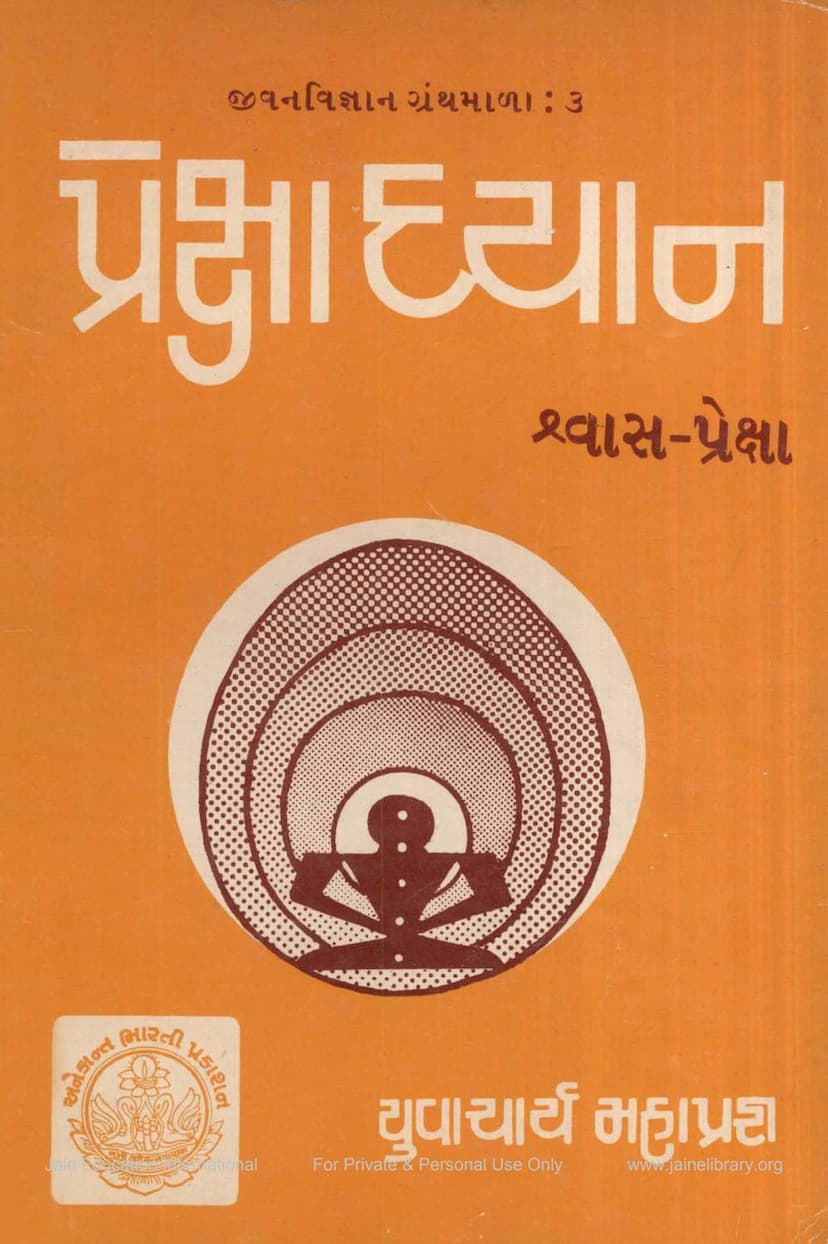Prekshadhyana Shwas Preksha
Added to library: September 2, 2025

Summary
Here's a comprehensive summary of the Jain text "Prekshadhyana Shwas Preksha" by Mahapragna Acharya, based on the provided pages:
Book Title: Prekshadhyana Shwas Preksha (Meditation: Breath Observation) Author: Yuvacharya Mahapragna Publisher: Anekant Bharati Prakashan Series: Jeevanvigyan Granthamala (Life Science Series) - Volume 3
This book, "Prekshadhyana Shwas Preksha," is part of a series introducing the techniques of Prekshadhyana, a meditation practice rooted in ancient Jain philosophy and adapted for modern scientific understanding. The core aim of Prekshadhyana is to facilitate transformation in individuals, leading to the eradication of base instincts and the establishment of non-violence, peace, and happiness in the world.
The book specifically focuses on Shwas Preksha (Breath Observation), presenting it as a fundamental and powerful tool for self-transformation and achieving self-reliance.
Key Concepts and Themes:
- Shwas (Breath) as the Bridge: The book emphasizes that breath is intrinsically linked to life and the body and mind. It acts as a crucial bridge, connecting the nervous system, mind, and life force (Prana). Breath is seen as the representative of all our energies.
- Prana (Life Force) and Breath: Breath is not merely the intake of air but also the acquisition of Prana, the vital life force that permeates the entire universe. This Prana, derived from the atmosphere, fuels all life activities. The deeper and more conscious the breath, the greater the flow of life force and consequently, enhanced energy and vitality.
- The Importance of Breath Observation: Shwas Preksha is presented as a direct method to connect with this Prana and channel it effectively. It is a technique that doesn't rely on external commands but encourages self-observation and systematic practice.
- Transformation through Breath: The book asserts that by altering the breath's rhythm and depth, one can bring about profound transformation in life. This includes overcoming negative emotions like anger, fear, greed, and delusion, and awakening inherent positive qualities.
- Scientific Basis of Breath: The text acknowledges the scientific understanding of the body's systems, particularly the respiratory system. It highlights that breathing is unique in that it can be controlled both voluntarily and involuntarily. This dual control makes breath an ideal anchor for focusing the mind.
- Breath as an Anchor for the Mind: The mind, often described as restless and erratic, can be calmed and stabilized by focusing on the breath. Breath serves as a stable, present-moment reality that anchors the mind, preventing it from getting lost in past memories or future imaginations.
- The Path from Gross to Subtle: Shwas Preksha is the initial step in the journey from the gross (physical) to the subtle (mental and spiritual). By becoming aware of the physical breath, one begins to understand the subtle workings of the mind and consciousness.
- Techniques for Deep Breathing (Deergha Shwas): The book details the process of deep breathing, emphasizing the role of the diaphragm and intercostal muscles in maximizing lung capacity. It explains how to consciously expand the chest and abdomen to draw in more vital air, thereby increasing Prana. This is presented as a means to reduce the breath rate and lengthen the breath, leading to calmness and reduced emotional turbulence.
- Types of Breath Observation:
- Deergha Shwas Preksha (Deep Breath Observation): Focuses on observing the slow, deep, and rhythmic breath, often characterized by a gentle movement in the abdominal region.
- Samavritti Shwas Preksha (Equal Breath Observation/Alternate Nostril Breathing): This involves consciously alternating the breath between the left and right nostrils. It is presented as a method for purifying the nervous system, enhancing cognitive abilities, and potentially opening doors to extrasensory perception. It highlights the balance between cooling (left nostril) and warming (right nostril) breaths.
- Consequences of Breath Patterns: The book contrasts normal breathing patterns with those occurring during emotional states. It notes that in states of agitation, desire, anger, or fear, breathing becomes shallow and rapid, whereas deep, slow breathing promotes calmness and well-being.
- Results and Benefits of Shwas Preksha:
- Mental Concentration: Enhances focus and strengthens the mind.
- Energy Awakening: Activates energy centers and awakens "Tejas" (inner radiance/energy).
- Nadi System Purification: Influences the subtle energy channels (nadis) in the body.
- Emotional Control: Aids in managing and controlling emotions.
- Awakening (Jagrukta): Cultivates heightened awareness and presence.
- Equanimity (Samabhav): Promotes a state of balance and non-attachment, leading to freedom from stress and mental tension.
- Knower-Seer Attitude (Jnana-Drashta Bhav): Develops the pure consciousness of being an observer, free from judgmental thought processes.
- Power Awakening: Leads to the awakening of latent powers and abilities by connecting with the source of energy.
In essence, "Prekshadhyana Shwas Preksha" by Mahapragna Acharya serves as a practical guide to harnessing the power of the breath for personal growth, mental clarity, emotional regulation, and spiritual advancement, all within a framework that respects both ancient wisdom and modern scientific inquiry.